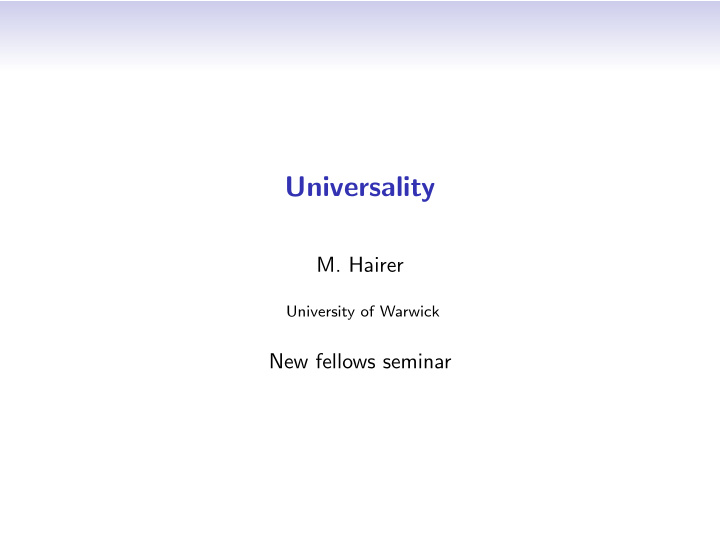



Universality M. Hairer University of Warwick New fellows seminar
Universality Experimental / numerical fact: large-scale behaviour of systems displaying random behaviour self-similar and independent of microscopic description.
Universality Experimental / numerical fact: large-scale behaviour of systems displaying random behaviour self-similar and independent of microscopic description. Example: Random walks / central limit theorem
Universality Experimental / numerical fact: large-scale behaviour of systems displaying random behaviour self-similar and independent of microscopic description. Example: Surface growth (KPZ)
Universality Experimental / numerical fact: large-scale behaviour of systems displaying random behaviour self-similar and independent of microscopic description. Example: Surface growth (KPZ)
Heuristic explanation Schematic evolution in “space of models” under rescaling: Want to understand these “fixed points” and this picture! Fixed points are universal scale-invariant models. Mathematically tractable when fixed point is Gaussian, very hard otherwise. (Conformal invariance helps a lot in 2 D .)
Heuristic explanation Schematic evolution in “space of models” under rescaling: Want to understand these “fixed points” and this picture! Fixed points are universal scale-invariant models. Mathematically tractable when fixed point is Gaussian, very hard otherwise. (Conformal invariance helps a lot in 2 D .)
Heuristic explanation Schematic evolution in “space of models” under rescaling: Want to understand these “fixed points” and this picture! Fixed points are universal scale-invariant models. Mathematically tractable when fixed point is Gaussian, very hard otherwise. (Conformal invariance helps a lot in 2 D .)
Intermediate situation Sometimes Gaussian and non-Gaussian fixed points coexist. Schematic evolution under rescaling: G N Can we understand red line and blue region? Weaker form of universality.
Intermediate situation Sometimes Gaussian and non-Gaussian fixed points coexist. Schematic evolution under rescaling: G N Can we understand red line and blue region? Weaker form of universality.
Interface fluctuation models Gaussian fixed point: Edwards-Wilkinson universality class. Exponents 1 / 2 in space and 1 / 4 in time. Gaussian fluctuations with explicit description. Nonlinear fixed point: KPZ universality class. Exponents 2 / 3 in space and 1 / 3 in time. Fluctuations described by random matrix (Tracy-Widom) distributions. No full description yet. Crossover regime: (red line) KPZ equation: x h + ( ∂ x h ) 2 + ξ . ∂ t h = ∂ 2 Behaves like EW at small scales and KPZ at large scales. Recent contribution: build robust solution theory allowing to show universality results.
Interface fluctuation models Gaussian fixed point: Edwards-Wilkinson universality class. Exponents 1 / 2 in space and 1 / 4 in time. Gaussian fluctuations with explicit description. Nonlinear fixed point: KPZ universality class. Exponents 2 / 3 in space and 1 / 3 in time. Fluctuations described by random matrix (Tracy-Widom) distributions. No full description yet. Crossover regime: (red line) KPZ equation: x h + ( ∂ x h ) 2 + ξ . ∂ t h = ∂ 2 Behaves like EW at small scales and KPZ at large scales. Recent contribution: build robust solution theory allowing to show universality results.
Interface fluctuation models Gaussian fixed point: Edwards-Wilkinson universality class. Exponents 1 / 2 in space and 1 / 4 in time. Gaussian fluctuations with explicit description. Nonlinear fixed point: KPZ universality class. Exponents 2 / 3 in space and 1 / 3 in time. Fluctuations described by random matrix (Tracy-Widom) distributions. No full description yet. Crossover regime: (red line) KPZ equation: x h + ( ∂ x h ) 2 + ξ . ∂ t h = ∂ 2 Behaves like EW at small scales and KPZ at large scales. Recent contribution: build robust solution theory allowing to show universality results.
Main problem Problem: Functions are not smooth. Usual definition of smoothness: Obviously bad idea!
Main problem Problem: Functions are not smooth. Usual definition of smoothness: Obviously bad idea!
Main problem Problem: Functions are not smooth. Usual definition of smoothness: Obviously bad idea!
Main problem Problem: Functions are not smooth. Usual definition of smoothness: Obviously bad idea!
A possible solution Main idea: construct purpose-built objects and describe solution in terms of these: Problem of ill-posed operations boils down to constructing them at the level of these objects.
A possible solution Main idea: construct purpose-built objects and describe solution in terms of these: Problem of ill-posed operations boils down to constructing them at the level of these objects.
Recommend
More recommend